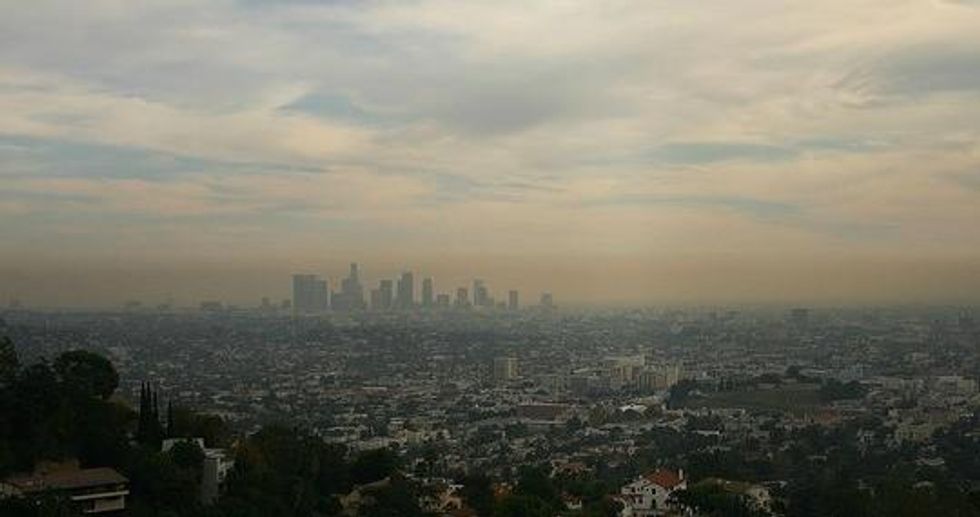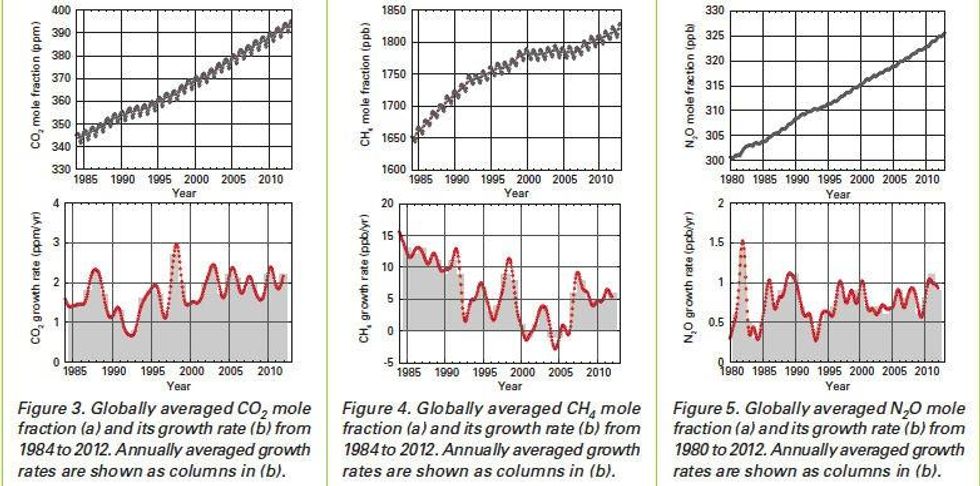

SUBSCRIBE TO OUR FREE NEWSLETTER
Daily news & progressive opinion—funded by the people, not the corporations—delivered straight to your inbox.
5
#000000
#FFFFFF
To donate by check, phone, or other method, see our More Ways to Give page.


Daily news & progressive opinion—funded by the people, not the corporations—delivered straight to your inbox.

According to WMO's annual Greenhouse Gas Bulletin, between 1990 and 2012 our atmosphere underwent a 32% increase in 'radiative forcing,' the warming effect on our climate, with carbon dioxide--"mainly from fossil fuel-related emissions"--accounting for 80% of this increase.
These observations, according to WMO Secretary-General Michel Jarraud, "highlight yet again how heat-trapping gases from human activities have upset the natural balance of our atmosphere and are a major contribution to climate change."
"Time is not on our side," Jarraud added, indicating the perils ahead if the trend is not halted or emissions reduced.
The Bulletin writes:
[O]n the global scale, the amount of CO2 in the atmosphere reached 393.1 parts per million in 2012, or 141% of the pre-industrial level of 278 parts per million. The amount of CO2 in the atmosphere increased 2.2 parts per million from 2011 to 2012, which is above the average 2.02 parts per million per year for the past 10 years, showing an accelerating trend.
The Greenhouse Gas Bulletin reports on concentrations of greenhouse gases such as carbon dioxide (CO2), methane (CH4) and nitrous oxide (N2O) that remain in the atmosphere after a percentage of the gases are absorbed into the biosphere and oceans.
In addition to the dramatic increase in atmospheric CO2, atmospheric methane reached a new high of about 1819 parts per billion (ppb) in 2012, or 260% of the pre-industrial level, due to increased emissions from human activities. Sixty percent of atmospheric methane comes from activities such as cattle breeding, rice agriculture, fossil fuel exploitation, landfills and biomass burning.
The report also found that the atmospheric concentration of nitrous oxide in 2012 was about 325.1 parts per billion, which is 0.9 parts per billion above the previous year and 120% of the pre-industrial level. Forty percent of atmospheric nitrous oxide comes from human activities such as biomass burning, fertilizer use, and various industrial processes.
Nitrous oxide, which is related to the destruction of the stratospheric ozone layer, has an impact on the climate 298 times greater than equal emissions of carbon dioxide over a 100-year period.
Citing the Intergovernmental Panel on Climate Change's (IPCC) latest Assessment Report, Jarraud notes that if we continue with 'business as usual,' global average temperatures may rise as much as 4.6 degrees higher than pre-industrial levels by the end of the century. "This would have devastating consequences," he notes.
"Our climate is changing, our weather is more extreme, ice sheets and glaciers are melting and sea levels are rising," adds Mr. Jarraud. "Limiting climate change will require large and sustained reductions of greenhouse gas emissions. We need to act now, otherwise we will jeopardize the future of our children, grandchildren and many future generations."

_____________________
Dear Common Dreams reader, The U.S. is on a fast track to authoritarianism like nothing I've ever seen. Meanwhile, corporate news outlets are utterly capitulating to Trump, twisting their coverage to avoid drawing his ire while lining up to stuff cash in his pockets. That's why I believe that Common Dreams is doing the best and most consequential reporting that we've ever done. Our small but mighty team is a progressive reporting powerhouse, covering the news every day that the corporate media never will. Our mission has always been simple: To inform. To inspire. And to ignite change for the common good. Now here's the key piece that I want all our readers to understand: None of this would be possible without your financial support. That's not just some fundraising cliche. It's the absolute and literal truth. We don't accept corporate advertising and never will. We don't have a paywall because we don't think people should be blocked from critical news based on their ability to pay. Everything we do is funded by the donations of readers like you. Will you donate now to help power the nonprofit, independent reporting of Common Dreams? Thank you for being a vital member of our community. Together, we can keep independent journalism alive when it’s needed most. - Craig Brown, Co-founder |

According to WMO's annual Greenhouse Gas Bulletin, between 1990 and 2012 our atmosphere underwent a 32% increase in 'radiative forcing,' the warming effect on our climate, with carbon dioxide--"mainly from fossil fuel-related emissions"--accounting for 80% of this increase.
These observations, according to WMO Secretary-General Michel Jarraud, "highlight yet again how heat-trapping gases from human activities have upset the natural balance of our atmosphere and are a major contribution to climate change."
"Time is not on our side," Jarraud added, indicating the perils ahead if the trend is not halted or emissions reduced.
The Bulletin writes:
[O]n the global scale, the amount of CO2 in the atmosphere reached 393.1 parts per million in 2012, or 141% of the pre-industrial level of 278 parts per million. The amount of CO2 in the atmosphere increased 2.2 parts per million from 2011 to 2012, which is above the average 2.02 parts per million per year for the past 10 years, showing an accelerating trend.
The Greenhouse Gas Bulletin reports on concentrations of greenhouse gases such as carbon dioxide (CO2), methane (CH4) and nitrous oxide (N2O) that remain in the atmosphere after a percentage of the gases are absorbed into the biosphere and oceans.
In addition to the dramatic increase in atmospheric CO2, atmospheric methane reached a new high of about 1819 parts per billion (ppb) in 2012, or 260% of the pre-industrial level, due to increased emissions from human activities. Sixty percent of atmospheric methane comes from activities such as cattle breeding, rice agriculture, fossil fuel exploitation, landfills and biomass burning.
The report also found that the atmospheric concentration of nitrous oxide in 2012 was about 325.1 parts per billion, which is 0.9 parts per billion above the previous year and 120% of the pre-industrial level. Forty percent of atmospheric nitrous oxide comes from human activities such as biomass burning, fertilizer use, and various industrial processes.
Nitrous oxide, which is related to the destruction of the stratospheric ozone layer, has an impact on the climate 298 times greater than equal emissions of carbon dioxide over a 100-year period.
Citing the Intergovernmental Panel on Climate Change's (IPCC) latest Assessment Report, Jarraud notes that if we continue with 'business as usual,' global average temperatures may rise as much as 4.6 degrees higher than pre-industrial levels by the end of the century. "This would have devastating consequences," he notes.
"Our climate is changing, our weather is more extreme, ice sheets and glaciers are melting and sea levels are rising," adds Mr. Jarraud. "Limiting climate change will require large and sustained reductions of greenhouse gas emissions. We need to act now, otherwise we will jeopardize the future of our children, grandchildren and many future generations."

_____________________

According to WMO's annual Greenhouse Gas Bulletin, between 1990 and 2012 our atmosphere underwent a 32% increase in 'radiative forcing,' the warming effect on our climate, with carbon dioxide--"mainly from fossil fuel-related emissions"--accounting for 80% of this increase.
These observations, according to WMO Secretary-General Michel Jarraud, "highlight yet again how heat-trapping gases from human activities have upset the natural balance of our atmosphere and are a major contribution to climate change."
"Time is not on our side," Jarraud added, indicating the perils ahead if the trend is not halted or emissions reduced.
The Bulletin writes:
[O]n the global scale, the amount of CO2 in the atmosphere reached 393.1 parts per million in 2012, or 141% of the pre-industrial level of 278 parts per million. The amount of CO2 in the atmosphere increased 2.2 parts per million from 2011 to 2012, which is above the average 2.02 parts per million per year for the past 10 years, showing an accelerating trend.
The Greenhouse Gas Bulletin reports on concentrations of greenhouse gases such as carbon dioxide (CO2), methane (CH4) and nitrous oxide (N2O) that remain in the atmosphere after a percentage of the gases are absorbed into the biosphere and oceans.
In addition to the dramatic increase in atmospheric CO2, atmospheric methane reached a new high of about 1819 parts per billion (ppb) in 2012, or 260% of the pre-industrial level, due to increased emissions from human activities. Sixty percent of atmospheric methane comes from activities such as cattle breeding, rice agriculture, fossil fuel exploitation, landfills and biomass burning.
The report also found that the atmospheric concentration of nitrous oxide in 2012 was about 325.1 parts per billion, which is 0.9 parts per billion above the previous year and 120% of the pre-industrial level. Forty percent of atmospheric nitrous oxide comes from human activities such as biomass burning, fertilizer use, and various industrial processes.
Nitrous oxide, which is related to the destruction of the stratospheric ozone layer, has an impact on the climate 298 times greater than equal emissions of carbon dioxide over a 100-year period.
Citing the Intergovernmental Panel on Climate Change's (IPCC) latest Assessment Report, Jarraud notes that if we continue with 'business as usual,' global average temperatures may rise as much as 4.6 degrees higher than pre-industrial levels by the end of the century. "This would have devastating consequences," he notes.
"Our climate is changing, our weather is more extreme, ice sheets and glaciers are melting and sea levels are rising," adds Mr. Jarraud. "Limiting climate change will require large and sustained reductions of greenhouse gas emissions. We need to act now, otherwise we will jeopardize the future of our children, grandchildren and many future generations."

_____________________